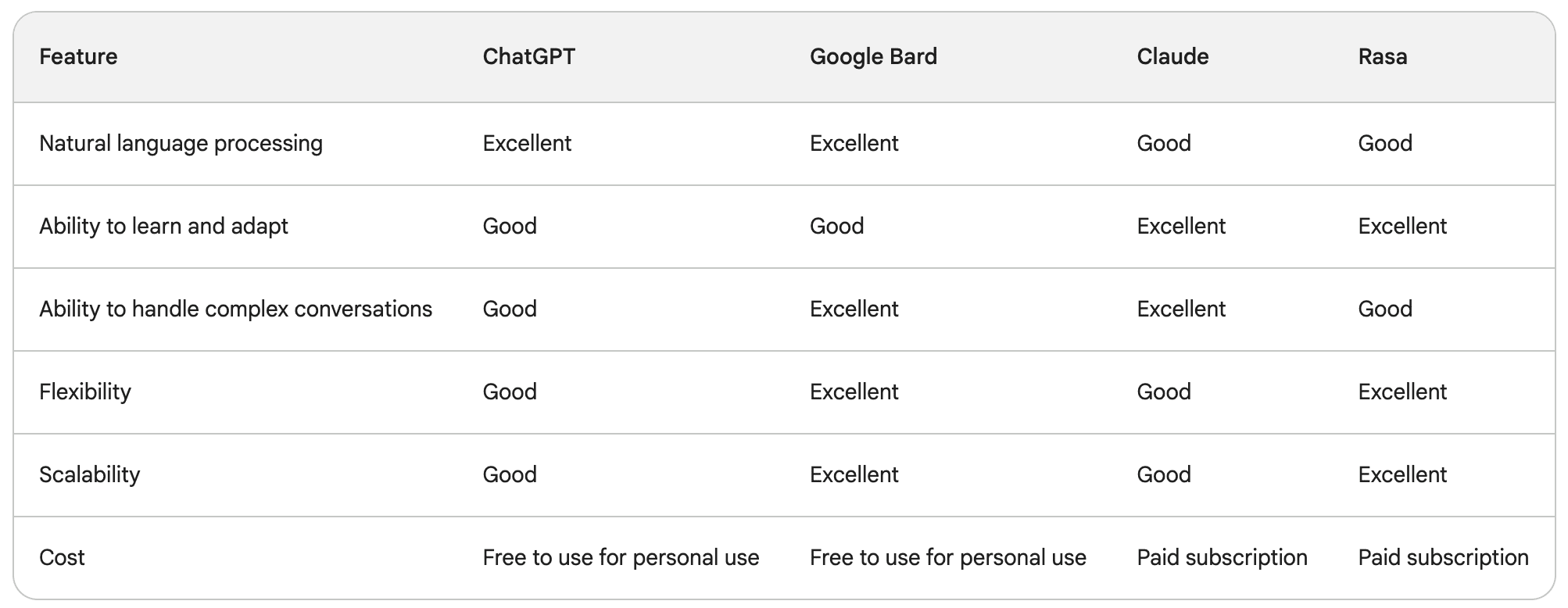
Recent articles
our mailing list
Battle of the Business Bots: Which AI Language Model is the best?

There’s no doubt you’ve heard about AI and if you’re here you’re probably wondering how you can start using it at work or in your business. You may even be feeling a little overwhelmed with the recent abundance of choice thats coming out lately from the AI world.
Don’t sweat it though! In this article, we’re diving deep into four of the most popular AI tools for personal and business use: ChatGPT, Claude, Google Bard, and Astra. We’ll go over the pros and cons of each service so you can make the decision on what suits you and your brand best.
What Is An AI Language Model?
First things first. What exactly is AI and what is an AI language model?
AI or Artificial Intelligence refers to the development of computer systems that can perform tasks that typically require human intelligence. These tasks include things like understanding natural language, recognising patterns, making decisions, solving problems, and learning from experience.
AI systems are designed to process large amounts of data, identify patterns within it, and use that knowledge to make informed decisions or predictions.
An AI language model is a type of artificial intelligence technology that specialises in understanding and generating human language. It’s designed to comprehend and generate text, just like a human would, by using sophisticated algorithms and large datasets. These models are trained on massive amounts of text data to learn the patterns, grammar, context, and semantics of language.
AI language models use techniques from natural language processing (NLP) and machine learning to process and understand text in various languages.
Why You Should Using One
Ai chatbots are incredibly useful for everyday tasks and for assisting with large amounts of data. They can perform a range of language-related tasks, including:
- Text Generation: Creating coherent and contextually relevant text based on a given prompt or topic.
- Language Translation: Translating text from one language to another while maintaining the intended meaning.
- Sentiment Analysis: Determining the emotional tone or sentiment expressed in a piece of text.
- Text Summarisation: Condensing lengthy texts into shorter, concise summaries.
- Question Answering: Providing accurate answers to questions posed in natural language.
- Language Understanding: Extracting information, entities, and meanings from text.
- Conversational Interaction: Engaging in human-like conversations by responding to user inputs.
This means the tasks they can help you range from writing you a shopping list or a short story to analysing the most recent financial reports of your company and seeing what areas are negatively impacting the business.
Choosing the Right AI Language Model
There are many AI language models available, and the right one for your business will depend on your specific needs and requirements. Here are some factors to consider when choosing an AI language model:
- The tasks you need the model to perform: What tasks do you need the AI language model to perform? Some models are better suited for certain tasks than others. For example, some models are better at generating text, while others are better at translating languages.
- The size of the model: The size of the model will affect its accuracy and performance. Larger models are typically more accurate, but they also require more computing power.
- The data the model is trained on: The data that the model is trained on will affect its accuracy and performance. Models that are trained on more data are typically more accurate.
- The cost of the model: The cost of the model will vary depending on the features and capabilities it offers.
- The level of customisation: Some models offer more customisation options than others. This can be important if you need the model to be tailored to your specific needs.
- The ease of use: The ease of use of the model will also be important. You want to choose a model that is easy to use and integrate with your existing systems.
Key Features Comparison
As discussed before there is a lot of things these AI chat services can do, so we’re just going to go over the central services we think are relevant for business application (so no rankings on the quality of each models recipe recommendations I’m afraid but don’t be afraid to try it out yourself).
We will compare the four most popular AI chat services and compare the pros and cons. and for those that aren’t bothered to read everything, we’ve summarised the main points in the table below. But for those who are interested in the nitty gritty, here is our comparison of the top four AI language model tools for businesses in 2023.

ChatGPT
ChatGPT is a state-of-the-art AI language model developed by OpenAI. It’s part of the GPT (Generative Pre-trained Transformer) series of models and is specifically designed for generating human-like text and engaging in interactive conversations. ChatGPT is trained on a vast amount of text data and is capable of understanding context, responding to prompts, and producing coherent and contextually relevant text.
Pros:
Efficient Customer Support: ChatGPT can provide instant responses to customer queries, enhancing the efficiency of customer support by addressing common inquiries and issues in real-time.
24/7 Availability: Unlike human agents who have working hours, ChatGPT can be available round the clock, ensuring customers always have a way to interact and receive assistance.
Scalability: ChatGPT can handle a high volume of customer interactions simultaneously, making it scalable for businesses experiencing varying levels of customer engagement.
Consistency: ChatGPT provides consistent responses, ensuring that customers receive uniform and accurate information across different interactions.
Cost Savings: Using AI like ChatGPT can potentially reduce labor costs associated with hiring and training human support agents, especially for routine and repetitive tasks.
Language Support: ChatGPT can communicate in multiple languages, facilitating interactions with customers from diverse linguistic backgrounds.
Cons:
Lack of Human Touch: ChatGPT might lack the empathy and emotional understanding that human customer support agents can provide, potentially leading to customer dissatisfaction in sensitive situations.
Misunderstandings: AI models like ChatGPT can sometimes misinterpret customer queries, leading to incorrect or irrelevant responses.
Complex Issues: While ChatGPT is proficient with simple inquiries, it might struggle with complex, technical, or nuanced issues that require deep domain expertise.
Privacy Concerns: Sharing sensitive information with an AI model raises concerns about data privacy and security, potentially causing customers to hesitate in sharing personal details.
Initial Setup: Integrating ChatGPT into existing business systems can require some technical expertise and initial setup time.
Dependency on Technology: Relying heavily on AI for customer interactions can become problematic if technical issues arise, leaving customers without immediate support.
Google Bard
Google Bard is also an open source language model, developed by Google AI. It is still under development, but it has been trained on a massive dataset of text and code, and can generate text, translate languages, write different kinds of creative content, and answer your questions in an informative way.
Pros
- Large model size: Google Bard is trained on a massive dataset of text and code, which gives it a large vocabulary and the ability to generate text that is more accurate and relevant than smaller models.
- Business-oriented training data: Google Bard is trained on a dataset of text and code that is specifically designed for business use. This means that it is more likely to generate text that is relevant to business applications.
- Easy to use: Google Bard is easy to use and can be integrated with other business applications.
- Affordable: Google Bard is free to use.
- Continuously learning: Google Bard is still under development, but it is constantly learning and improving. This means that it is likely to become more accurate and relevant over time.
- Open-sourced: Like ChatGPT, Google Bard is open-sourced, which is when the developers make the source code of the software available to the public to be used, modified, and redistributed. With its decentralised nature, it encourages open collaboration and feedback loops that can be significant in helping the AI improve.
Cons
- Still under development: Google Bard is still under development, so it may not be perfect. It may sometimes generate text that is inaccurate, offensive, or biased.
- Lack of customisation options: Google Bard does not offer as many customisation options as some other AI language models. This can be a limitation for businesses with specific needs.
- Not available in all languages: Google Bard is currently only available in English. This is a limitation for businesses that operate in other languages.
- May not be suitable for all tasks: Google Bard is a powerful AI language model, but it may not be suitable for all tasks. It is good with code but struggles with more creative writing for blogs and such.
- Privacy Concerns: Google Bard like ChatGPT has had questions raised on its protection of private data. We recommend reading this article from Forbes for more details.
- May be biased: Google Bard is trained on a dataset of text and code that is created by humans. This means that it may be biased towards certain viewpoints or groups of people. It is important to be aware of this bias and take steps to mitigate it.
Tidio
Tidio AI is a chatbot platform that uses artificial intelligence to automate customer service. It can be used to answer customer questions, resolve issues, and provide support.
Pros
- Easy to use: Tidio AI is a user-friendly platform that can be set up and used by businesses of all sizes.
- Scalable: Tidio AI can be scaled to meet the needs of growing businesses.
- Feature-rich: Tidio AI offers a variety of features that can help businesses improve their customer service, including live chat, chatbots, and email automation.
- Integrations: Tidio AI can be integrated with other business applications, such as CRM systems and marketing automation platforms.
- Support: Tidio AI offers 24/7 support to help businesses get the most out of the platform.
- Customisable: Tidio AI is customisable, so businesses can tailor it to their specific needs.
Cons
- Limited language support: Tidio AI is currently only available in English, French, German, Spanish, Portuguese, and Italian.
- May not be suitable for all businesses: Tidio AI may not be suitable for all businesses, such as businesses that need to handle complex customer queries.
- The level of customisation available may vary depending on the plan that you choose: Businesses that want to take advantage of all of Tidio AI’s customisation capabilities may need to upgrade to a more expensive plan.
Claude
Claude AI, crafted by Anthropic, stands as a substantial language model chatbot in the making. Although its development is ongoing, Claude AI has undergone training on an extensive collection of text and code. This enables it to craft text, perform language translation, create diverse forms of imaginative content, and furnish informative responses to your queries.
Pros
- Customer service: Claude AI can be used to answer customer questions, provide support, and resolve issues.
- Marketing: Claude AI can be used to generate marketing copy, write social media posts, and create other marketing materials.
- Sales: Claude AI can be used to qualify leads, generate sales proposals, and answer customer questions.
- Product development: Claude AI can be used to generate ideas for new products and services, and to collect feedback on existing products.
- Research: Claude AI can be used to research topics, summarise research papers, and generate presentations.
- Customisable: Claude offers customisable features per business.
- Available in many languages: Claude is available in more languages than Astra, making it a better fit for businesses that operate in multiple languages.
Cons
- Still under development: Claude AI is still under development, so it may not be perfect. It may sometimes generate text that is inaccurate, offensive, or biased.
- Lack of customization options: Claude AI does not offer as many customization options as some other AI language models. This can be a limitation for businesses with specific needs.
- Not available in all languages: Claude AI is currently only available in English. This is a limitation for businesses that operate in other languages.
- May not be suitable for all tasks: Claude AI is a powerful AI language model, but it may not be suitable for all tasks. For example, it may not be able to generate creative text or translate languages accurately.
Trends and Future Developments
AI is developing faster than anyone anticipated, and to be the best its always recommended to stay ahead of the trends. So here are just some of the predicted trends for businesses and AI chat models we’ll be seeing over the next several years:
- Increased use of AI chat models for customer service: AI chat models are becoming increasingly popular for customer service. They can be used to answer customer questions, resolve issues, and provide support 24/7.
- Integration of AI chat models with other business applications: AI chat models are being integrated with other business applications, such as CRM systems and marketing automation platforms. This allows businesses to use AI chat models to improve their customer experience and marketing campaigns.
- Personalization of AI chat interactions: AI chat models are becoming more personalized. They can learn about individual customers’ preferences and deliver more relevant and engaging experiences.
- Use of AI chat models for sales and marketing: AI chat models are being used for sales and marketing. They can be used to qualify leads, generate sales proposals, and answer customer questions.
- Development of more advanced AI chat models: AI chat models are constantly being developed. New models are being created that are more accurate, more intelligent, and more capable of understanding and responding to human language.
AI chat models are becoming increasingly important for businesses. They offer a variety of benefits, such as improved customer service, increased efficiency, and personalised experiences. As AI chat models continue to develop, they will become even more powerful and versatile tools for businesses.
Case studies
Here are some specific examples of how AI chat models are being used by businesses today:
- Banks: Banks are using AI chat models to answer customer questions about their accounts, products, and services.
- Retailers: Retailers are using AI chat models to help customers find products, answer questions, and place orders.
- Travel companies: Travel companies are using AI chat models to help customers book flights, hotels, and other travel arrangements.
- Healthcare providers: Healthcare providers are using AI chat models to answer patient questions, schedule appointments, and provide support.
- Education institutions: Education institutions are using AI chat models to help students with their coursework, answer questions, and provide support.
These are just a few examples of how AI chat models are being used by businesses today. As AI chat models continue to develop, they will be used in even more ways to improve the way businesses operate.
Embracing AI
From automating tasks that used to eat up hours to uncovering insights that inspire game-changing strategies, AI has emerged as the ultimate game-changer for businesses of all sizes. So, whether you’re a tech giant or a local startup, embracing AI isn’t just a trend; it’s a strategic move that can steer your business toward a future of innovation and success.
By understanding the strengths and limitations of each AI tool and aligning them with your business requirements, you can make an informed decision and harness the power of AI to drive growth and success.
If you’re interested in learning more about the multiple ways you can use AI heck out our article on how to write the ultimate ChatGPT prompt.

Article by
Simon Gould
CEO / Founder / Dad
Founder and leader, Simon established SDM back in 2012. Since then, he has helped 150 clients (and counting) to achieve their digital goals.[…]



